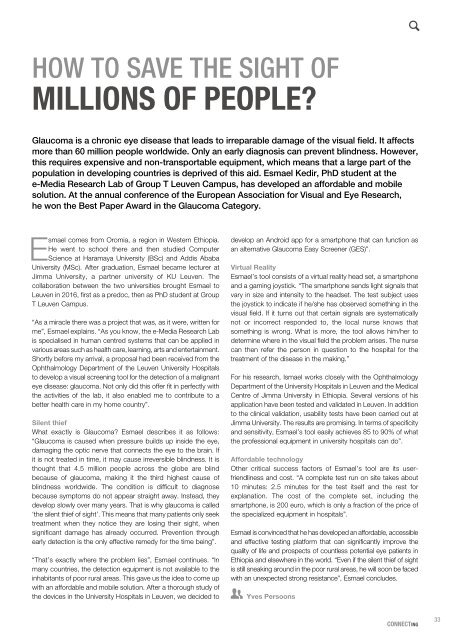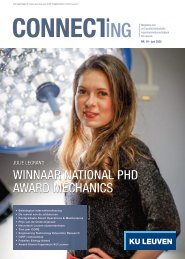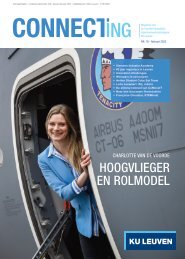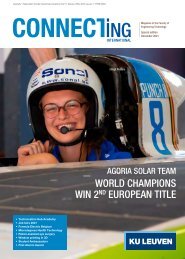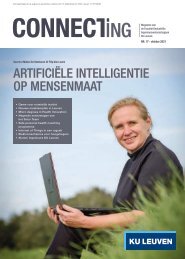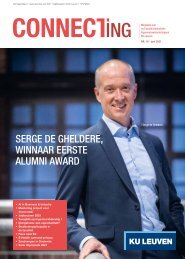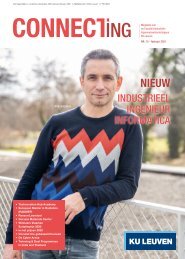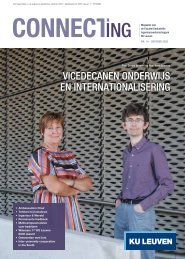ConnectING 13
Create successful ePaper yourself
Turn your PDF publications into a flip-book with our unique Google optimized e-Paper software.
HOW TO SAVE THE SIGHT OF<br />
MILLIONS OF PEOPLE?<br />
Glaucoma is a chronic eye disease that leads to irreparable damage of the visual field. It affects<br />
more than 60 million people worldwide. Only an early diagnosis can prevent blindness. However,<br />
this requires expensive and non-transportable equipment, which means that a large part of the<br />
population in developing countries is deprived of this aid. Esmael Kedir, PhD student at the<br />
e-Media Research Lab of Group T Leuven Campus, has developed an affordable and mobile<br />
solution. At the annual conference of the European Association for Visual and Eye Research,<br />
he won the Best Paper Award in the Glaucoma Category.<br />
Esmael comes from Oromia, a region in Western Ethiopia.<br />
He went to school there and then studied Computer<br />
Science at Haramaya University (BSc) and Addis Ababa<br />
University (MSc). After graduation, Esmael became lecturer at<br />
Jimma University, a partner university of KU Leuven. The<br />
collaboration between the two universities brought Esmael to<br />
Leuven in 2016, first as a predoc, then as PhD student at Group<br />
T Leuven Campus.<br />
“As a miracle there was a project that was, as it were, written for<br />
me”, Esmael explains. “As you know, the e-Media Research Lab<br />
is specialised in human centred systems that can be applied in<br />
various areas such as health care, learning, arts and entertainment.<br />
Shortly before my arrival, a proposal had been received from the<br />
Ophthalmology Department of the Leuven University Hospitals<br />
to develop a visual screening tool for the detection of a malignant<br />
eye disease: glaucoma. Not only did this offer fit in perfectly with<br />
the activities of the lab, it also enabled me to contribute to a<br />
better health care in my home country”.<br />
Silent thief<br />
What exactly is Glaucoma? Esmael describes it as follows:<br />
“Glaucoma is caused when pressure builds up inside the eye,<br />
damaging the optic nerve that connects the eye to the brain. If<br />
it is not treated in time, it may cause irreversible blindness. It is<br />
thought that 4.5 million people across the globe are blind<br />
because of glaucoma, making it the third highest cause of<br />
blindness worldwide. The condition is difficult to diagnose<br />
because symptoms do not appear straight away. Instead, they<br />
develop slowly over many years. That is why glaucoma is called<br />
‘the silent thief of sight’. This means that many patients only seek<br />
treatment when they notice they are losing their sight, when<br />
significant damage has already occurred. Prevention through<br />
early detection is the only effective remedy for the time being”.<br />
“That’s exactly where the problem lies”, Esmael continues. “In<br />
many countries, the detection equipment is not available to the<br />
inhabitants of poor rural areas. This gave us the idea to come up<br />
with an affordable and mobile solution. After a thorough study of<br />
the devices in the University Hospitals in Leuven, we decided to<br />
develop an Android app for a smartphone that can function as<br />
an alternative Glaucoma Easy Screener (GES)”.<br />
Virtual Reality<br />
Esmael’s tool consists of a virtual reality head set, a smartphone<br />
and a gaming joystick. “The smartphone sends light signals that<br />
vary in size and intensity to the headset. The test subject uses<br />
the joystick to indicate if he/she has observed something in the<br />
visual field. If it turns out that certain signals are systematically<br />
not or incorrect responded to, the local nurse knows that<br />
something is wrong. What is more, the tool allows him/her to<br />
determine where in the visual field the problem arises. The nurse<br />
can then refer the person in question to the hospital for the<br />
treatment of the disease in the making.”<br />
For his research, Ismael works closely with the Ophthalmology<br />
Department of the University Hospitals in Leuven and the Medical<br />
Centre of Jimma University in Ethiopia. Several versions of his<br />
application have been tested and validated in Leuven. In addition<br />
to the clinical validation, usability tests have been carried out at<br />
Jimma University. The results are promising. In terms of specificity<br />
and sensitivity, Esmael’s tool easily achieves 85 to 90% of what<br />
the professional equipment in university hospitals can do”.<br />
Affordable technology<br />
Other critical success factors of Esmael’s tool are its userfriendliness<br />
and cost. “A complete test run on site takes about<br />
10 minutes: 2.5 minutes for the test itself and the rest for<br />
explanation. The cost of the complete set, including the<br />
smartphone, is 200 euro, which is only a fraction of the price of<br />
the specialized equipment in hospitals”.<br />
Esmael is convinced that he has developed an affordable, accessible<br />
and effective testing platform that can significantly improve the<br />
quality of life and prospects of countless potential eye patients in<br />
Ethiopia and elsewhere in the world. “Even if the silent thief of sight<br />
is still sneaking around in the poor rural areas, he will soon be faced<br />
with an unexpected strong resistance”, Esmael concludes.<br />
Yves Persoons<br />
CONNECTING<br />
33


